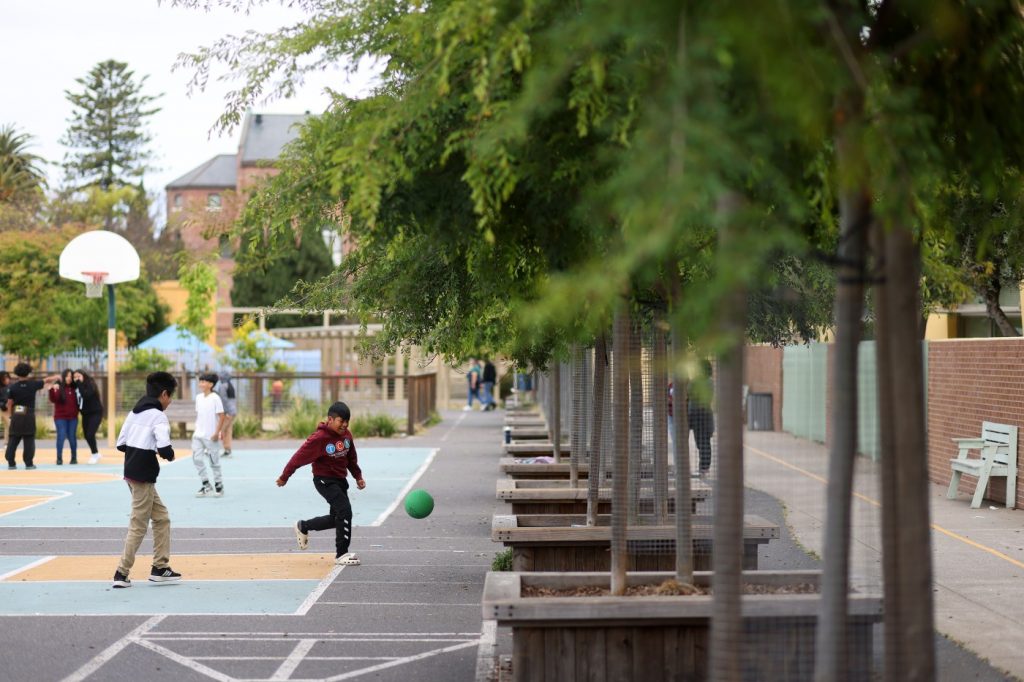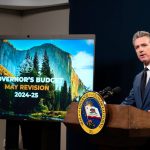As summer approaches and temperatures soar, one of the most dangerous places for Bay Area students might actually be the playground.
On a hot, sunny day, the asphalt on school playgrounds can reach 149 F, while a rubber mat can reach 165 F, according to UCLA’s Luskin Center for Innovation. That’s hot enough to cause a third-degree burn. But a little shade can go a long way to help kids cool off.
In an effort to provide more green on Bay Area schoolyards — many of which are expanses of barren asphalt without grass, shade or trees — and lower the impact on students’ health, the Trust for Public Land, a national nonprofit that works to create parks and protect public land, is campaigning for $1 billion from the state legislature to transform those playgrounds.
“If you look at our elementary schools in many cases, you don’t see nature. It’s all about blacktop, asphalt,” said Guillermo Rodriguez, the Trust for Public Land’s California director. “(At) some of the schools that we’ve targeted for green schoolyards, playgrounds have turned into parking lots for teachers and staff because the kids weren’t using it.”
Rodriguez said the core feature of a green schoolyard is the replacement of asphalt with natural materials, but can also include planting more trees and incorporating nature into the space.
“The policies of how we build public schools are still so antiquated,” Rodriguez said. “(It’s) very much focused on four walls and a roof and not the campus. We’re really trying to change the way that schools are built, designed and redeveloped.”
The Trust for Public Land partnered with Oakland Unified School District in 2018 to begin transforming the district’s playgrounds into green spaces. Through the Oakland Green Schoolyards program, the nonprofit has revamped four campus schoolyards — including the Cesar E. Chavez Education Center — to be safer and more eco-friendly.
The district has 14 additional schools with planning projects in the works, including Horace Mann and Fruitvale elementary schools, West Oakland Middle School and Coliseum College Prep Academy.
“Hundreds of students at Oakland schools have already gotten to play, learn and be closer to nature on Trust for Public Land playgrounds and we’re excited for all students whose schools will receive these same kinds of upgrades,” said district Superintendent Kyla Johnson-Trammell.
In his budget revision unveiled last week, Gov. Gavin Newsom eliminated the remaining $375 million for the School Facilities Aid Program, which provides funding to school districts for facility-related repairs and construction.
But the state legislature is currently considering two bills – Senator Steve Glazer’s SB 28 and Assemblymember Al Muratsuchi’s AB 247 – that would place a $14 billion to $15.5 billion bond measure on the November ballot to fund construction and modernization of school facilities.
The Trust for Public Land’s request would include a $1 billion allocation in the bond for green schoolyard funding.
Rodriguez said the nonprofit was inspired to campaign for the $1 billion allocation after witnessing the success of the 2022-23 CAL FIRE Urban and Community Forestry Green Schoolyards grant program.
Under CAL FIRE’s grant, the state awarded a total of $117 million to nearly 30 schools and nonprofits to design and build their own projects. Awards ranged from $200,000 to $21 million.
Rodriguez said $1 billion could fund projects at nearly 500 high-priority schools. But he acknowledged the risk that voters might not support a multi-billion dollar bond measure.
Related Articles
The first electric school bus fleet in the US will also power Oakland homes
Letters: Missing data | Runaway bureaucracy | CalWORKs cuts | State accountability | U.N. peacekeeping
Want to teach? New Alameda County program tackles teacher shortage with low-cost credential program
Voters narrowly support upping parcel tax for Los Gatos, Saratoga high schools
California gym teacher who said she was fired for Christian beliefs will get $360,000
The last statewide school bond proposal, Prop 13, was rejected by California voters in 2020. The bond measure would have borrowed $15 billion to modernize and build public schools and colleges.
“I think there is some general concern,” Rodriguez admitted. “Are voters in California comfortable, willing and ready to make important investments in public infrastructure, like our public schools?”
Rodriguez said by including green schoolyards in the facilities bond, they gain climate-focused voters and increase the likelihood of passing the bond measure.
“Over 100 million people don’t live within a 10-minute walk to a quality park or open space,” but they probably live within walking distance of a school, he said.
“If California does this, it’ll be the first state in the country to really do this in earnest from a state policy perspective,” Rodriguez said. “We can really move the park equity needle significantly in this country.”


